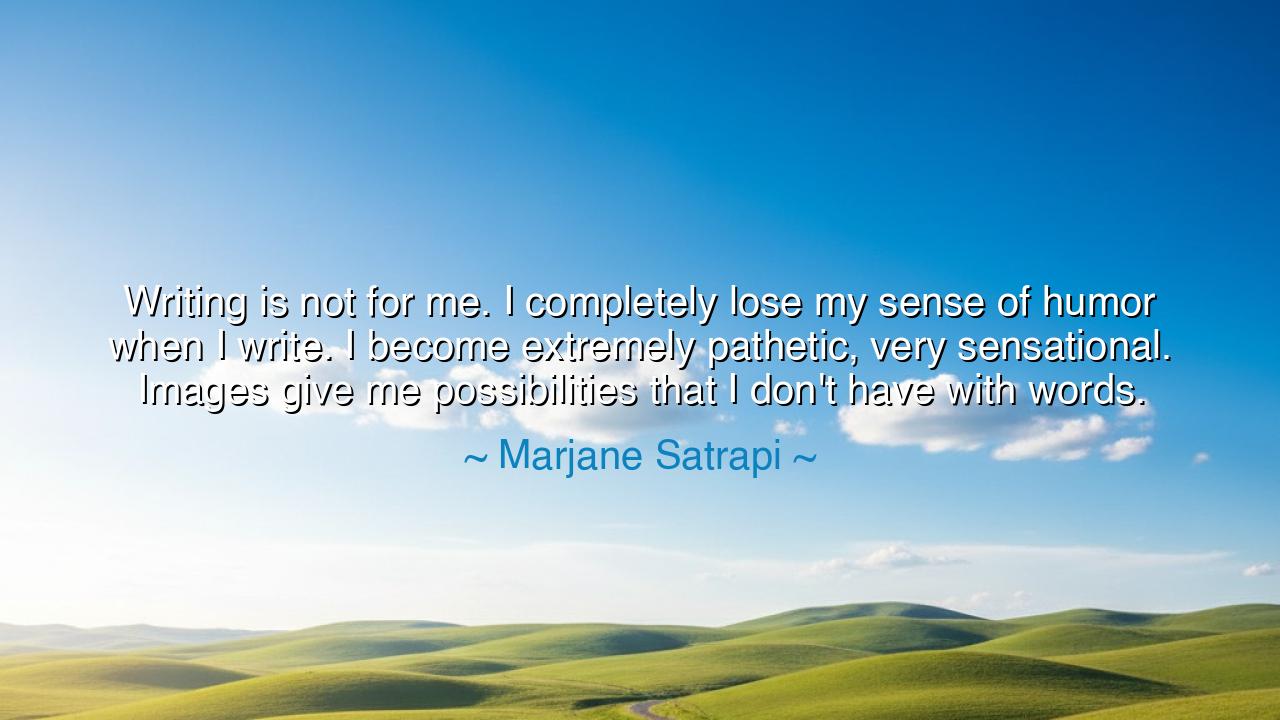
Writing is not for me. I completely lose my sense of humor when I
Writing is not for me. I completely lose my sense of humor when I write. I become extremely pathetic, very sensational. Images give me possibilities that I don't have with words.






In the words of Marjane Satrapi, “Writing is not for me. I completely lose my sense of humor when I write. I become extremely pathetic, very sensational. Images give me possibilities that I don't have with words.” These are not the words of someone rejecting art, but of someone recognizing the sacred language of her own soul. In this confession lies a powerful truth: that every creator has their native element, and to force expression through another medium is to silence part of oneself. Satrapi, a storyteller of images, speaks here as one who understands that truth does not always descend through words—it sometimes shines through vision.
The ancients, too, knew that there were many languages of creation. The poet sang, the sculptor carved, the painter called light into being. None were higher than the other; each revealed a fragment of the eternal. To one, the word is a sword of clarity; to another, the image is a window into the infinite. Satrapi’s admission—that in writing she loses humor and becomes too heavy—echoes this timeless recognition. Her laughter, her humanity, her subtle balance between sorrow and satire, flow not through sentences but through lines of ink, faces drawn in despair or defiance, eyes that speak what language cannot contain.
Consider Leonardo da Vinci, who filled notebooks with words, yet confessed that painting spoke what writing could never say. He wrote that painting “is poetry seen rather than felt,” and that to capture truth with the hand is sometimes more honest than to shape it with the tongue. So too does Satrapi’s art—her graphic novels, most famously Persepolis—speak truths too vast for prose. The written word binds her in gravity, but the image sets her free. In her drawings, the laughter of youth and the terror of war coexist—simple black and white figures carrying the full weight of history.
When Satrapi says that “images give me possibilities that I don’t have with words,” she is declaring her allegiance to the language of vision, that oldest and most immediate form of communication. Long before alphabets were carved in stone, humankind painted upon cave walls. There, in the flicker of torchlight, hunters and dreamers gave birth to story through form and shadow. The eye, more ancient than speech, knows truth without translation. In the image, emotion and intellect meet—one does not merely understand, one feels. This is the kingdom Satrapi inhabits, where humor, pathos, and truth blend into a single stroke of ink.
But there is another wisdom here. When she says she becomes “extremely pathetic, very sensational” in writing, she speaks of the dangers of misalignment—when a soul works against its nature. To create authentically, one must find the medium that reflects one’s spirit. The ancient Greek sculptor Phidias could not have sung his vision into being, nor could Homer have painted his epics. The river of creation flows differently through each heart. Those who force themselves into another’s form create not art, but artifice. Thus Satrapi’s humility is not weakness—it is clarity. She knows her realm, and in that knowledge lies her genius.
There is, too, a lesson about humor and honesty. The written word, in its precision, can trap emotion; but image, with its freedom, lets irony and tenderness live side by side. Through visual art, Satrapi preserves the playfulness of her vision even amid darkness. She transforms pain into poetry not through eloquence but through symbol—the power of a simple line to contain a universe. Her art teaches that sometimes to speak less is to say more, and that the truest laughter often lives beside tears.
So let this wisdom be carried forward: Find your own language of truth. Whether it be words, colors, sounds, or silence, seek the form that makes your spirit sing. Do not chase mastery in the wrong medium, for each soul is born to create in its own way. Remember that the image, the gesture, the note, the word—each is a vessel of the same divine fire. As Satrapi reminds us, the path of the artist is not to imitate others, but to discover where one’s truth flows without resistance. For when you find that form, whether written or drawn, your creation will not merely communicate—it will live.






AAdministratorAdministrator
Welcome, honored guests. Please leave a comment, we will respond soon